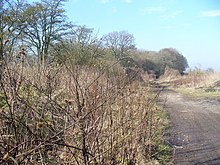Harrow Way

The Harrow Way (also spelled as "Harroway") is another name for the "Old Way", an ancient trackway in the south of England, dated by archaeological finds to 600–450 BC, but probably in existence since the Stone Age.[1][2] The Old Way ran from Seaton in Devon to Dover, Kent. Later the eastern part of the Harrow Way become known as the Pilgrims' Way in the 19th century: the latter was a route invented by Albert Way of the Ordnance Survey, who imagined it (without evidence) to have been a pilgrimage route which ran from Winchester, Hampshire, via Farnham, Surrey, to Canterbury Kent.[3][4] The western section of the Harrow Way ends in Farnham, the eastern in Dover.
The name may derive from herewag, a military road, or har, ancient (as in hoary) way, or heargway, the road to the shrine (perhaps Stonehenge).[5] It is sometimes described as the 'oldest road in Britain' and is possibly associated with ancient tin trading.[6]


The Old Way
[edit]The Eastern part of the Harrow Way
[edit]The eastern part of the Harrow Way (Old Way) from Farnham, Surrey, later known as the Pilgrims' Way, runs on or parallel to the North Downs Way National trail. The Harrow Way can be traced from Rochester and alternative Channel ports on the Straits of Dover. A principal track also starting in the valley of the Great Stour from Canterbury, to lead along the North Downs or its southern slopes, through Maidstone and Guildford to Farnham, Surrey. With its natural season-round well-drained soil, slightly more humus-rich than the crest itself, forming the most travelled of often several terraced routes.[7]
The Pilgrims' Way, diverts from the Harrow Way and continues from Farnham to Winchester. This pilgrimages route helped the growth of Winchester. Winchester, apart from being an ecclesiastical centre in its own right (the shrine of St Swithin), was an important regional focus and an aggregation point for travellers arriving through the seaports on the south coast.[7] (See Early British Christianity).
Farnham, was a second aggregation point for travellers joining from the south coast.[7] Gibson reports the section going eastward just north of Farnham ran through the area now Farnham Park and continued its course along the chalk outcrop, crossed the Bagshot Road where the Six Bells pub now stands and continued past Badshot Lea, Surrey where an important Neolithic Long Barrow burial mound (tumulus) was found. The Harrow Way then continues to the crest of the Hog's Back where the ancient trackway is known to have run.[8] There are several barrows along the Hog's Back.
Western section
[edit]
The western part of the Old Way, the Harrow Way, can be traced from Farnham, Surrey west through Basingstoke and Andover to Salisbury Plain and Stonehenge, Wiltshire, through Dorset and on to Seaton on the Devon coast.[6][9] In Dorset, the Harrow Way can be traced through the villages of Halstock and Corscombe, where it is known as Common Lane. At the Halstock end, a short length was realigned to form the access for a Roman villa (which was built on the site of a late Iron Age farmstead).[10]
References
[edit]- ^ Brayley, Edward (1850). A topographical history of Surrey. Vol. 4. London: G Willis. p. 218. OCLC 4601837.
- ^ Margary, Ivan D (1948). Roman Ways in the Weald. London: J M Dent. pp. 260–263. ISBN 0-460-07742-2.
- ^ Alexander, Matthew; Tales of Old Surrey ISBN 0-905392-41-8
- ^ Hooper, Wilfrid (1936). "The Pilgrims' Way and its supposed pilgrim use". Surrey Archaeological Collections. 44. Guildford: Surrey Archaeological Society: 47.
In their train have followed the host of guide-books and popular writers who have expanded and embellished ad libitum as fancy prompted
- ^ Grinsell, Leslie (1958). The archaeology of Wessex. London: Methuen. p. 298. OCLC 400319.
- ^ a b Daily Telegraph. 9 Oct 2008 Greywell and the Harroway. Christopher Somerville sets out on his 200th Walk of the Month
- ^ a b c Wright, Christopher John (1971). Pilgrims' Way. London: John Constable. p. 15. ISBN 0-09-456240-7.
- ^ J.H. Gibson MD, Surrey Archaeological Society, Prehistoric Finds
- ^ Saxon Farnham by Elfrida Manning, Phillimore & Co, 1970
- ^ P.R. Lemmey, A History of Halstock, ISBN 0-9512063-0-3
